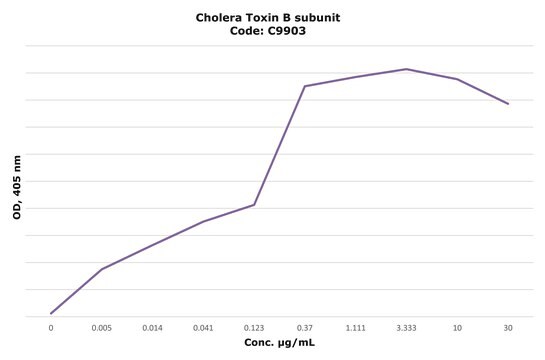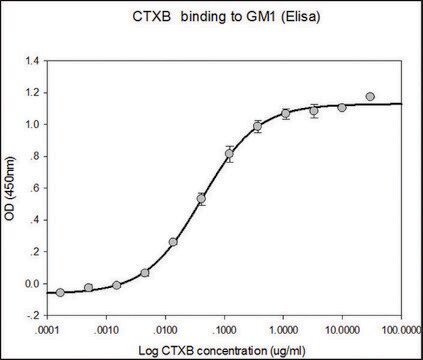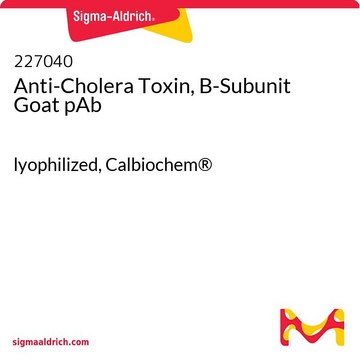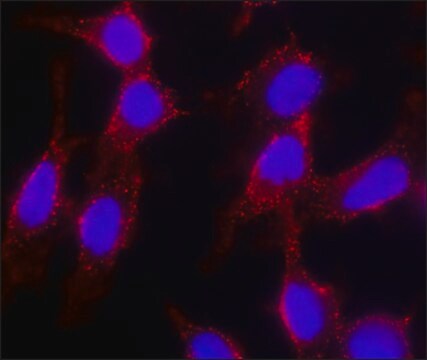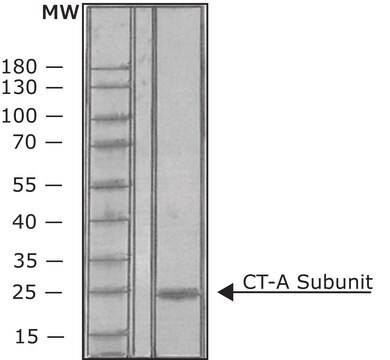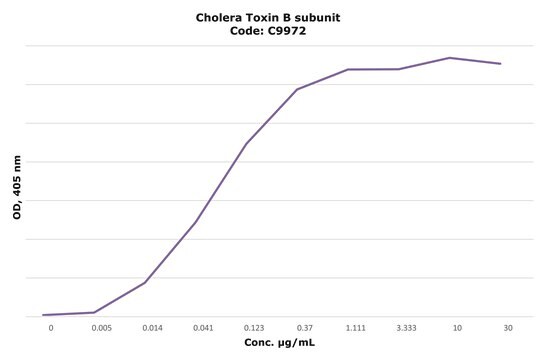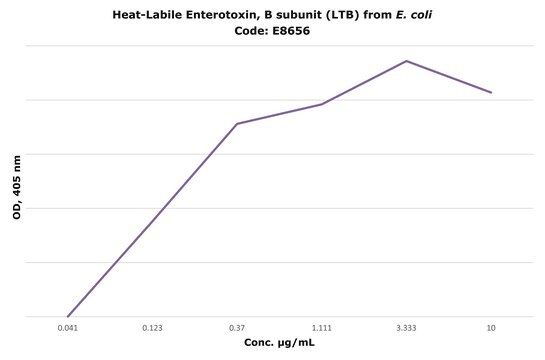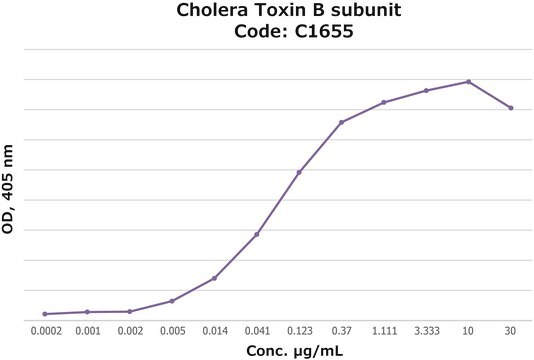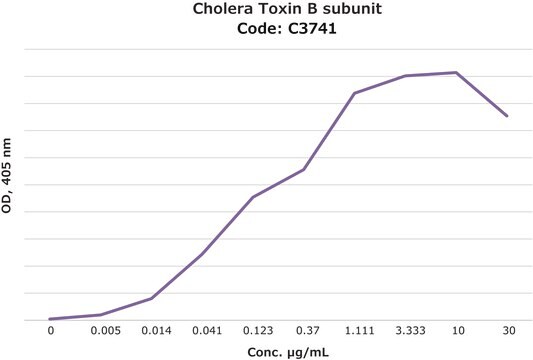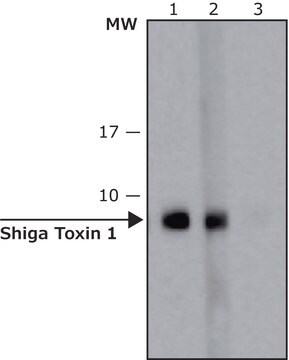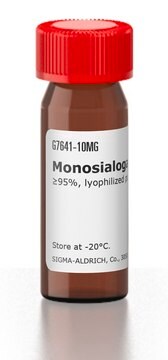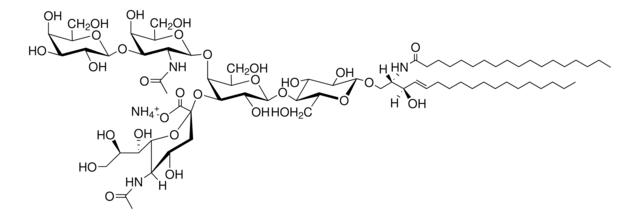C3062
Anti-Cholera Toxin antibody produced in rabbit
whole antiserum
Synonim(y):
Cholera Toxin Antibody
Zaloguj sięWyświetlanie cen organizacyjnych i kontraktowych
About This Item
Polecane produkty
pochodzenie biologiczne
rabbit
Poziom jakości
białko sprzężone
unconjugated
forma przeciwciała
whole antiserum
rodzaj przeciwciała
primary antibodies
klon
polyclonal
zawiera
15 mM sodium azide
metody
Ouchterlony double diffusion: 1:16
dot blot: 1:20,000
indirect ELISA: 1:8,000
Warunki transportu
dry ice
temp. przechowywania
−20°C
docelowa modyfikacja potranslacyjna
unmodified
Opis ogólny
Cholera toxin, the pathogenic agent of cholera, is made of two subunits, A (27 kDa) and B (12 kDa) assembled with the stoichiometry AB5. The B-subunit binds to specific receptors, the monosialogangliosides GM1, located in the membrane of intestinal epithelial cells. The A1 fragment of the A-subunit is translocated through the membrane of the host cell, where it catalyses the ADP-ribosylation of the Gsa regulatory component of the adenylate cyclase complex. The resulting increased level of cyclic AMP promotes a wide variety of actions, including the secretion of chloride ions in the case of intestinal epithelial cells.
The antiserum reacts versus Cholera toxin, but shows no reaction versus Staphylococcal enterotoxin A, Staphylococcal enterotoxin B and Pseudomonas exotoxin A (protein concentration: 50-500 ng/dot). The product has not been tested for neutralization potency against active Cholera toxin.
Immunogen
toxin from Vibrio cholerae
Zastosowanie
Anti-Cholera Toxin antibody produced in rabbit has been used in:
- western blotting
- quantitative ganglioside-dependent enzyme-linked immunoassay (ELISA)
- double immunodiffusion
Działania biochem./fizjol.
Cholera toxin (CT), a multifunctional protein plays a role in the immune system. It possesses immunomodulatory, adjuvant properties and also acts as an anti-inflammatory agent. Its immunomodulatory properties can be utilized to treat several autoimmune disorders. CT can serve as one of the best model of a multifunctional protein.
Uwaga dotycząca przygotowania
delipidized
Oświadczenie o zrzeczeniu się odpowiedzialności
Unless otherwise stated in our catalog or other company documentation accompanying the product(s), our products are intended for research use only and are not to be used for any other purpose, which includes but is not limited to, unauthorized commercial uses, in vitro diagnostic uses, ex vivo or in vivo therapeutic uses or any type of consumption or application to humans or animals.
Ta strona może zawierać tekst przetłumaczony maszynowo.
Nie możesz znaleźć właściwego produktu?
Wypróbuj nasz Narzędzie selektora produktów.
Kod klasy składowania
12 - Non Combustible Liquids
Klasa zagrożenia wodnego (WGK)
WGK 1
Temperatura zapłonu (°F)
Not applicable
Temperatura zapłonu (°C)
Not applicable
Wybierz jedną z najnowszych wersji:
Masz już ten produkt?
Dokumenty związane z niedawno zakupionymi produktami zostały zamieszczone w Bibliotece dokumentów.
Klienci oglądali również te produkty
Dazhi Jin et al.
Journal of clinical microbiology, 51(12), 3968-3974 (2013-09-21)
We report here the quantitative detection of Vibrio cholerae toxin (CT) in isolates and stool specimens by dynamic monitoring of the full course of CT-mediated cytotoxicity in a real-time cell analysis (RTCA) system. Four cell lines, including Y-1 mouse adrenal
Generation and characterization of a live attenuated enterotoxigenic Escherichia coli combination vaccine expressing six colonization factors and heat-labile toxin subunit B
Turner AK, et al.
Clinical and Vaccine Immunology : CVI, 18(12), 2128-2135 (2011)
Qiyao Wang et al.
Infection and immunity, 83(9), 3381-3395 (2015-06-10)
Diverse environmental stimuli and a complex network of regulatory factors are known to modulate expression of Vibrio cholerae's principal virulence factors. However, there is relatively little known about how metabolic factors impinge upon the pathogen's well-characterized cascade of transcription factors
Tatiana El Hage et al.
The FEBS journal, 274(10), 2614-2629 (2007-04-25)
Using the in situ liver model system, we have recently shown that, after cholera toxin binding to hepatic cells, cholera toxin accumulates in a low-density endosomal compartment, and then undergoes endosomal proteolysis by the aspartic acid protease cathepsin-D [Merlen C
Christine A Pellino et al.
Journal of bacteriology, 198(11), 1621-1630 (2016-03-24)
Shiga toxin (Stx)-producing Escherichia coli (STEC) is a major cause of foodborne illness, including the life-threatening complication hemolytic-uremic syndrome. The German outbreak in 2011 resulted in nearly 4,000 cases of infection, with 54 deaths. Two forms of Stx, Stx1 and
Nasz zespół naukowców ma doświadczenie we wszystkich obszarach badań, w tym w naukach przyrodniczych, materiałoznawstwie, syntezie chemicznej, chromatografii, analityce i wielu innych dziedzinach.
Skontaktuj się z zespołem ds. pomocy technicznej